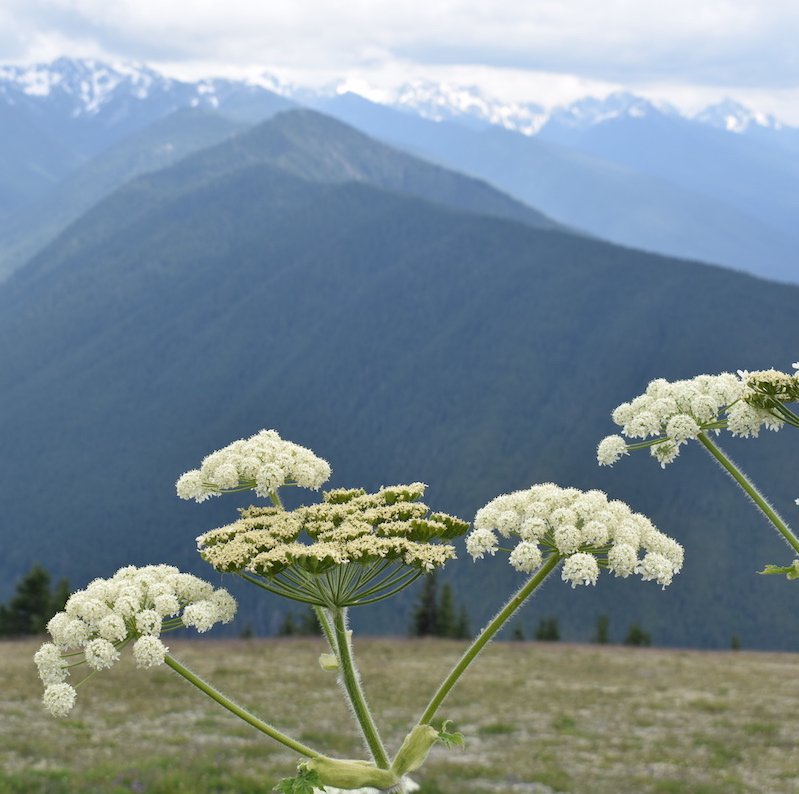
Peggy Cleveland
Olympic National Park in Washington is one of the crown jewels of the national park system. It has one of the most diverse ecosystems of all the parks. There are seven ecosystems, each distinctly different. You will find snow-covered mountains, old-growth rainforests, and over 70 miles of wild coast. This wilderness coast is one of the longest stretches in the continental U.S. It is truly wild with a treacherous shoreline and strong currents. Waves crash against a rocky coastline filled with sea stacks. The Olympic Peninsula has charming small towns along the coast and the Hood Canal, and the interior is Olympic National Park and the Olympic National Forest. It is over a 350-mile drive around the perimeter of the park. You can spend a week here and not even scratch the surface of all there is to see and do.
Videos by TravelAwaits
Hurricane Ridge
If you have ever watched the opening scenes to The Sound of Music, it is what comes to mind when you see the alpine-like meadows at the top of Hurricane Ridge. You have to time it just right to get the best views. Late afternoon the fog begins to roll in, so you will want to visit earlier in the day. On a clear day, you can see the surrounding ridges of the Olympic Mountains and across the Strait of Juan De Fuca, the Salish Sea’s outlet to the Pacific Ocean and Canada. The Cirque Rim trail is an easy, paved, .5-mile walk from the parking lot and is wheelchair accessible. Great views. You can access the Big Meadow trail, which is also paved and takes you through those Sound of Music meadows. For a slightly more strenuous hike, take the High Ridge trail, a .5-mile loop. Make sure to add the .1-mile dead-end spur trail to Sunrise Point for 360-degree views. The visitor center has a movie, snack bar, and a wonderful gift shop.

Peggy Cleveland
Olympic National Park Lodging
The park has a variety of lodging nestled in the most scenic areas of the park and forest. The grand Lake Quinault Lodge is located amidst a rainforest on grounds overlooking the lake. Built in 1926, this iconic hotel is the epitome of what you expect from a national park lodge. The Kalaloch Lodge is the only coastal lodging in the park and is perched on a bluff overlooking the Pacific Ocean. The Sol Duc Hot Springs Resort is surrounded by forests and is just steps from the hot spring pools. The historic Lake Crescent Lodge and Log Cabin Resort, built in 1915, is a turn-of-the-century resort. It looks out over the lovely Lake Crescent, surrounded by hemlock and fir trees, and the mountains come right to the water’s edge.
Pro Tip: Book a Quinault Rainforest Tour. This 4-hour tour brings you to the best photo spots in the Quinault rainforest. The knowledgeable guides will share the unique flora and fauna as well as the history of the area. Short walks from the tour bus will take you into the rainforest and a historic farm. Well worth the time.
Lake Crescent
You can’t miss seeing Lake Crescent as it is so large it dominates the terrain. It is a glacially-carved lake with crystal-clear waters due to the lack of nitrogen. When the light hits the lake just right, it shimmers with a blue-green color. A nice hike in this area is to Marymere Falls, which is a little less than 2 miles roundtrip. The trail meanders through an old-growth forest to the 90-foot waterfall. Even if you don’t stop, the drive along Hwy 101 around the lake is stunning.

Peggy Cleveland
Elwa Valley
The Elwa Valley is a wonderful example of environmental recovery due to one of the largest ecosystem restoration projects in National Park Service history. In the early 1900s, the Elwa watershed’s impressive salmon runs came to an end with the construction of two dams. It dramatically changed the ecosystem of the area. In September 2011, work began to remove the Elwa Dam with the Glines Canyon Dam removed in 2014. Once the Elwa River began flowing freely, the salmon returned. The Elwa Valley is rapidly reverting to its natural state, with vegetation and wildlife returning.
Unfortunately, portions of the road have washed out. Park at the Madison Falls trailhead and walk the wheelchair-accessible, paved, .1-mile trail to the 60-foot falls that tumble into a beautiful pool. You can still explore the Elwa Valley area along the Olympic Hot Springs road, but you must be on a bicycle or on foot. The gate is just beyond the Madison Falls parking lot. There are no visitor facilities beyond the gate, so pack in and out what you need. There is a bypass trail around the flood damage.
Pro Tip: The Elwa River Restoration Brochure has information on the national park’s visitor centers with exhibits about the Elwa River project and history. It also lists museums and sites in Port Angeles to learn more about this fascinating project.
Kalaloch
The Kalaloch area highlights the wide variety of habitats on this wild coast. Olympic National Park protects 64 miles of pristine coastline, while the Olympic Coast National Marine Sanctuary protects the marine environment and offshore islands. This area is teeming with life, from otters and fish foraging in the kelp beds to tufted puffins nesting on sea stacks and rocky outposts. At low tide, you can peer in tidepools searching for sea life.
The Tree of Life and its root cave are a unique freak of nature. It is located near the Kalaloch campground. Erosion has washed all the soil from the roots of this tree, and it appears to be floating in the air. With the harsh winds of the Pacific Coast, trees topple all the time, but somehow this one manages to survive.
Ruby Beach is the most popular in the park and draws the crowds to its unique sea stacks and ruby-colored sands. It is truly lovely, but it can get crowded. Along the same stretch of coastline are Beaches 1-4 and 6, each with its own parking lot. These will give you a similar experience.
Pro Tip: Visit the coast near sunset. The sun setting over the Pacific Ocean is something you will never forget. Truly epic.

Peggy Cleveland
Hoh Rain Forest
This is a bit of a detour from Highway 101 to the Hoh Rain Forest, but so worth it. The drive in from the coast is 18 miles each way and parallels the Hoh River. The terrain changes dramatically from farmland to rainforest once you enter the park. This pristine wilderness looks much the same as it did 5,000 years ago. Almost 12 feet of rainfall each year helps create a lush forest filled with ferns and moss-covered trees. People tend to be chatty, but even the most vocal come to a stunned silence when they hike the Hall of Mosses Trail and enter the moss-draped maple grove. I can only describe it as nature’s cathedral. It is an unforgettable experience.
There are a variety of trails available from the Hoh Rain Forest Visitor Center. For first-timers, the Hall of Mosses trail is an easy .8-mile loop with just a 100-foot elevation gain, but it is at one point, so it feels rather steep but then levels off. The Spruce Nature Trail is a 1.2-mile loop. This trail passes through old and new growth forests. Then, you pass by the Hoh River, which has great views of the river and mountains. The trail then follows the crystal clear spring-fed Taft Creek to return near the visitor center. The two trails are easy to combine for a nice 2-mile hike which is not too strenuous. For those with mobility issues, the visitor center is surrounded by old-growth trees and a .1-mile flat and paved mini-trail.
Pro Tip: Make sure to gas up. The nearest gas station is in Forks, 31 miles away.

Peggy Cleveland
Rialto Beach
Rialto Beach and the Mora area of Olympic National Park is another area of the park you will need to drive over 50 extra miles each way from Highway 101 to get to, but it’s totally worth it. This is one of the wildest beaches in the country. Crashing waves pummel the shoreline with its towering sea stacks and the giant drift log strewn beach. You want to time your visit to get here about an hour and a half before low tide so that you can hike down to the Hole in the Wall and explore the tidepools. Make sure to check a tide chart so that you don’t get caught during high tide. This area is not suitable for those with mobility issues. The hike was a lot more challenging than I expected due to the rocky beach. You will walk on shifting stones, or if you get closer to the water, you will walk on very soft, rocky sand. It is tough-going, and then halfway there, you find a small stream that requires logs to get across in the spring. In the warmer summer months, you can just walk across.
The Mora area is filled with towering trees but what makes it distinctive for a forest hike is the roar of the Pacific Ocean. The James Pond Trail will take you through the forest in a .3-mile loop to the pond. The Slough Trail is .9 mile and leads to the Quillayute River.
This gives you a glimpse of the many experiences you can enjoy while visiting the Olympic National Park. The park is so vast I am always finding something new to do each time I visit.
Pro Tip: See some big trees. Olympic National Park is filled with huge trees, many of them record-breaking. Some are easy to get to, such as the world’s largest Sitka Spruce Tree located in the Lake Quinault area. Others require long hikes to access gargantuan trees.
Related Articles:
